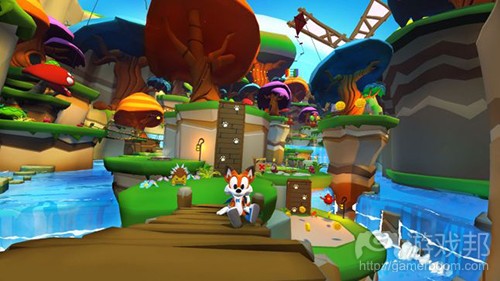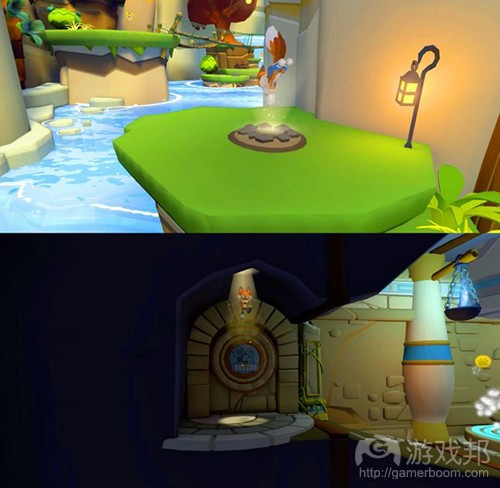如何有效平衡VR与传统游戏玩法
作者:Dan Hurd
《Lucky’s Tale》是Playful Corp.平台上一款面向虚拟现实的平台游戏,是伴随着Oculus Rift而发行的。这不仅是我们的第一款虚拟现实游戏,也是我们的第一款平台游戏。虽然我们曾因如此巨大的任务感到害怕,但我们还是努力去解决了一系列来自这一未知领域的设计问题。而其中一个非常有趣的问题便是去处理环境的需求与游戏玩法的需求之间微妙的平衡。
将玩家与色彩鲜艳且活力四射的世界连接在一起
VR的巨大潜能意味着玩家能够完全沉浸到游戏环境,游戏世界以及游戏关卡中,这是传统的2D游戏所做不到的。这是难以用言语进行阐述的,你可以进入游戏世界中自由探索,近距离感受这个世界或基于自己喜欢的角度去认识它。或者你也可以想象自己踏进电视屏幕中,即进入你正在玩的游戏里或者你正在观看的节目中。就好像你在孩童时期玩的玩具突然化成真实的对象并站在你面前。
我们的目标是最大化这种让人惊叹的感受,即让玩家在进入《Lucky’s Tale》的世界中会有一种亲切感。为此我们需要围绕着特定时刻,即基于玩家视线所到之处,游戏玩法发生之处,高视差位置等地方创造关卡,并突显所有范围去创造让人难以忘怀的景象和强烈的场所感。
为了做到这点我们采取的一种方法便是在关卡中创造小小的密封空间从而将各种环境细节缩短到一臂之遥的范围内,在这里视差感会变得很强,并且会让玩家体会到强烈的“虚拟现实”感。这些较小的区域与那些更广大的区域将排列在一起,并且将作为重要的视觉提示。让我们举个例子来说吧,在某个关卡中你将从一个低海拔的草原开始,并需要爬到风车中的一个狭窄坑道中。另一方面,你的视线将覆盖一片五彩森林的全貌。
你忘记停下来感受玫瑰的香气!
我们花了很多时间去创造我们觉得吸引人且让人亲切的VR场所。但在游戏测试期间人们却径直走过它们并走向下一个敌人,为此我们真的非常心痛。我们发现我们经常会提醒玩家:“记住,你们可以看看四周!”但是当看到玩家点点头后又继续朝着下个目标前进时我们只能哭丧着脸而无可奈尔。
对此我们产生了一些想法:“也许我们可以在玩家第一次玩游戏并即将错过一些很酷的内容时主动提醒他们看看四周!然后我们可能不得不笨拙地从窗口或其它什么地方退出去。”显然这并不是一个好主意。
比起任何其它媒体,在虚拟现实中玩家不愿意朝周边看是一个更显著的问题:因为朝周边环境看便意味着Lucky有可能会完全离开你的视线。而这是彻底违背游戏的核心概念,即游戏会在你知晓Lucku的周边环境并保护其安危的时候给与你奖励。我们便意识到在关卡的一开始,即还未出现任何威胁时玩家会看向四周(即移动自己的头部),但是随着他们在游戏中走的更远并遭遇更多危险时,他们的头部移动便会越来越少。
忍者的代码并不会将你暴露在攻击对象面前(这也是为什么我们要突出Nightingale Floors机制),我们的玩家便牢记了这一代吗所以才不会将视线从Lucky身上移开!VR游戏设计中存在一种有趣的张力:即通过挑战和对游戏机制的掌握去创造一种“流”状态,玩家头上所佩戴的全范围摄像机将呈现出相对的视野。
让人放松的安全区域
我们一直在努力使这些元素拥有更加平衡的状态:有时候我们希望玩家能够愉快地游戏,有时候我们却希望他们能够停下来感受花香。我们希望通过轻微的碰触做到这点—-即去调动玩家的好奇心。
我们发现的一种方法便是在一些不同世界规模间转换。在玩家游戏的时候通过软件去操控他们的瞳孔距离,我们可以模糊原本正确的路线并清除威胁对象而提供给玩家能够发挥好奇心和探索心理的安全空间。
对此的最佳例子便是我们的“隐蔽处”功能,即Lucky可以穿越土堆进入一个地下世界。在地下世界中,规模会发生改变,突然间玩家会觉得所有东西都变成迷你的复杂模型一般。这些内容的存在是为了让玩家在一般关卡进程期间拥有喘息的机会,同时它们也能够帮助我们去推动游戏“流”,让玩家能够暂时松懈下来并适应全新环境和视角。在这种情况下玩家通常都会四处张望。我们同时也会将玩家带离这个世界并提供给他们截然不同的感觉。当Lucky离开地下世界并回到正常规模时玩家需要再次适应这种变化,这也让原来的关卡变得更加新鲜。即玩家将会再一次重新环视这个关卡。
我们决定添加更多像这样“环顾四周”的时刻。我们需要某些时刻比隐蔽处转换更微妙,并且不只是依赖于规模转换。为此我们将利用关卡的收缩与扩展并通过在进程中的主要转换后创造安全空间而进一步延伸这一概念。这些安全区域没有任何敌人,并且存在一些显著的可收集目标,同时也没有明显的出口。所以这将推动玩家停下来并对周边的事物产生好奇。当他们在了解前进道路的景象时会看到像猫头鹰或蝴蝶等引人注意的事物。从玩家所发出的“哦”或“啊”的声音中我们便知道这些内容设定是平衡的。
当我们开始规划《Lucky’s Tale》故事的下一个章节时我们仍然尝试了这一平衡。当你再次与Lucky见面时,我们一定会提供给你更多在不牺牲具有挑战的游戏玩法的前提下如何创造吸引人的虚拟现实的答案!
(本文为游戏邦/gamerboom.com编译,拒绝任何不保留版权的转发,如需转载请联系:游戏邦)
The art of balancing traditional gameplay with powerful immersion in VR
by Dan Hurd
Lucky’s Tale, a made-for-Virtual-Reality platforming game, at Playful Corp., just shipped packed-in with every Oculus Rift, and we’re honored and excited to be a part of this momentous launch. This is both our first virtual reality game and our first platforming game. When we weren’t collectively screaming in terror at the enormity of our task, we were trying to solve a host of design issues that came with this uncharted territory. One of the more interesting ones was navigating the tenuous balance between the demands of the environment and the demands of gameplay.
Connecting players intimately to a colorful, vibrant world
The incredible potential of VR means players can fully immerse themselves in an environment, a world, on a level previously impossible with traditional 2D of any kind. It’s difficult to describe with words, the joy of transporting into a world where you can freely look around, lean in for a closer and detailed look, or explore little details from any angle you choose. Instead, imagine stepping past the glass on your TV screen and entering the game you’re playing, or the show you’re watching. Picture yourself as a kid playing with toys which suddenly come to life in front of you.
Our goal was to maximize this awe-inspiring feeling to the extent that players felt an intimate sense of presence when they entered Lucky’s world. Making it work within a game context required building our levels around specific moments where sightlines, gameplay encounters, scale, high-parallax motion, and lighting all converage to create unforgettable sights and a strong sense of place.
One way we did this was by creating small, enveloping ‘rooms’ within our levels to bring lots of environmental detail into arm’s reach, where parallax motion is strong and it feels very ‘VR’. Like peanut butter and chocolate (or my preference, nougat and tripe), these smaller areas are nicely juxtaposed next to larger, more grandiose set pieces, which serve as visual cues to take in the view. For instance, in one level you start out in a small, low-elevation grassland and have to climb up to a narrow tunnel inside a windmill. On the other side, the sightline explodes in a panoramic view of a beautiful, multicolored forest.
You forget to stop and smell the roses!
We spent a lot of time crafting what we felt were a compelling, intimate VR locations or some grandiose set-piece. But during playtests people would just blast by them on their way to the next enemy or collectible and we would die a little inside, thankful that the Rift hid our bitter, bitter tears from the play testers. We often found ourselves saying, “Remember, you can look all around!” and then we would grimace as our players gave a small nod and continued pursuing the next objective.
Wild thoughts would coalesce: “Maybe we can ship one of us to each player at the moment they first play the game and prompt them to look around when they’re about to miss something awesome! And then we’d have to leave awkwardly through a window or something.” This was not a good sign.
Our players’ reluctance to look around was a symptom of a very interesting problem that was more pronounced in virtual reality than any medium we had previously encountered: being able to look anywhere in the world meant that sometimes Lucky could completely leave your field of view. This pushed directly against a core concept of the game, which rewarded you for being aware of Lucky’s immediate surroundings and keeping him safe. We eventually realized just by watching their head movement that most people looked around at the beginning of a level, where it was safe, but as they progressed further and encountered more danger, their heads moved less and less.
The code of the ninja is to never leave yourself open to attack (which is why our office features Nightingale Floors), and our players were taking the code to heart and never taking their eyes off Lucky! Therein lies an interesting tension in VR game design: achieving a state of ‘flow’ through challenge and mastery of game mechanics — typically a very good thing — and its opposition to an aesthetic appreciation of the sights a full-range head-controlled camera affords.
Safety is love, safety is life
We struggled with how to get these elements into a more balanced state: sometimes we want our players to have fun with the game, and sometimes we want them to stop and smell the roses. We wanted to accomplish this with a light touch — to make it more driven by player curiosity than anything else.
One method we stumbled upon was transitioning between several slightly different scales of the world. By manipulating the player’s inter-pupillary-distance via software as they play the game, we subtly obfuscate the correct path in tandem with clearing out threats to provide a safe space that encourages curiosity and exploration.
The best example of this scale-shifting is our ‘foxhole’ feature, where Lucky plunges headfirst into a subterranean world through mounds in the topsoil. Once below, the scale shifts and suddenly everything feels like a miniature, intricate model. These were created in part to give players a break from the normal level progression, but they also help us push against gameplay ‘flow’, allowing the player to loosen up and re-orient to their new environment and perspective. This usually comes with a much larger degree of looking around. We also pull the player out of the world — foxhole ‘dioramas’ float in darkness — to further give them a feeling of difference. The player has to reorient when Lucky emerges from the foxhole and transitions back to the normal scale, making the same level feel fresh and new. Commence more looking around (and more happy dancing in the background by Playful devs — never pass on an opportunity to be outrageously silly when someone’s ears and eyes are covered by a big black mask).
We decided to add even more ‘look-around’ moments like this. We needed some of them to be subtler than the foxhole transition and not rely on scale shifts. To that end, we leveraged the constriction and expansion of our levels — like the juxtaposing of ‘rooms’ against expansive panoramas — and took the concept further by creating safe spaces right after major transitions in the path. These safe zones contain no enemies, few obvious collectibles or goals, and no immediately obvious exit. This forces players to stop and become detectives. As they investigate the landscape for the path forward, something cool looking, like an owl or a butterfly fluttering toward them will often distract them. Much ‘ooh’, much ‘ahh’, and we smile a bit knowing that the force is in balance once again, at least until the next disruption.
We’re still experimenting with this balance as we begin to plan for the next chapter in Lucky’s story. You can be sure that when you meet Lucky again, we’ll have even more answers for how to make virtual reality amazing without sacrificing the challenging gameplay.(source:Gamasutra)
上一篇:分析《崩溃季节》的关卡设计
下一篇:有关电子游戏预告片的6大经验教训









































 闽公网安备35020302001549号
闽公网安备35020302001549号